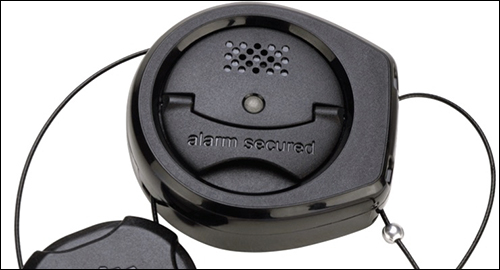With the use of EPC ultrahigh-frequency (UHF) RFID technology increasing in stores for inventory management, and more recently for electronic article surveillance (EAS), Checkpoint Systems has developed an RFID-enabled version of its Spider Wrap line of products. These alarming devices for high-value items allow users to trigger alerts and capture inventory-management data when a product is removed from a store, based on RFID tag reads.
Checkpoint, a global technology firm that provides loss-prevention and merchandise-visibility solutions for the retail industry, has sold its Alpha High-Theft Solutions Attack Spider Wrap and Mini Spider Wrap products for the past decade. The reusable, battery-powered devices come with cords that can be wrapped tightly around a product, and can emit an alert if an individual attempts to cut the cord. It can provide that same alerting response if a product with a Spider Wrap attached moves past an EAS device at the door.
That provides a layer of security for high-value items such as electronics, explains Stuart Rosenthal, the sales and marketing VP for Checkpoint’s Alpha High-Theft Solutions line. Recently, however, the company has been receiving requests from its retailer customers for a similar product that employs RFID instead of EAS technology. That’s because more stores are already equipped with RFID gates to capture tag reads, and because RFID data could not only trigger the alert, but also provide specific product information at the time that an item is being removed.
Checkpoint began developing an RFID version of its Spider Wraps last year for use in stores, then released the product on Feb. 12. “Like most of our products,” Rosenthal says, “these were developed in collaboration with our customers.” The RFID version has a built-in Checkpoint UHF RFID inlay encoded with a unique ID number, but no EAS functionality.
In a typical use case, Rosenthal says, a retailer may already have an RFID inlay sticker for inventory management and point-of-sale use. The RFID-enabled Spider Wrap would be an added layer of protection as an EAS-based system. A store typically would attach the security wrap around the packaging of a new product when that item was received. The system could then be used for theft prevention, with the RFID reader triggering an alert if it read a tag, while also forwarding that data to the retailer’s software.
If someone in the store were to attempt to cut the wrap’s cord, the device, like its EAS-enabled predecessor, would emit an alert in the form of a flashing light and a 98-decibel alarm to serve as a deterrent to thieves. If he or she attempted to simply walk out of the store with the Spider Wrap attached, the RFID reader would capture the device’s tag ID, sound an alarm and (if enabled to do so) update the store’s inventory system to indicate what had been removed.
This means retailers can use their existing RFID readers for theft deterrence of high-value items, without installing an EAS gateway. Companies that lack an existing RFID system can install the readers from Checkpoint or other technology providers to capture the Spider Wraps’ tag IDs, as well as those of any RFID tags that enter the store already attached to items.
In either case, Checkpoint reports, the new product is intended to make theft protection and inventory management of high-value items more flexible. Several companies already intend to use the technology, the firm notes, and are presently in the process of applying the new RFID-enabled Spider Wraps to their products.
Whether EAS- or RFID-enabled, the device comes in three sizes. The Mini Spider Wrap comes with a 32-inch cable length, for use on products such as housewares, coffee makers, iPods, portable DVD players, software, video game hardware, video games, and ink and toner cartridges. It includes a lithium battery and an aircraft grade cable with a flashing LED. The larger Attack Spider Wrap comes with 70- or 102-inch cable lengths, for medium to large packaged goods such as computers, televisions, power tools and boxed electronics. It, too, comes with a red flashing LED and a lithium battery, as well as an aircraft-grade cable.
Rosenthal says the price of the RFID-enabled Spider Wrap will be comparable to that of the traditional EAS version (which the company will continue to sell). He sees a continued demand for both models of the product. “As RFID becomes more common,” he states, “this offers more flexibility for retailers.” He expects the product to have greater impact over time as more RFID deployments take place. “This is a very good-quality product that should have a positive impact,” he says, for those with RFID technology in their stores.


